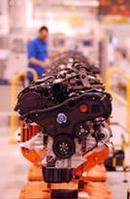Ford Dagenham's award-winning 'green' vision
 Ford Dagenham's newest engine production line has won a green award within two months of starting up.
Ford Dagenham's newest engine production line has won a green award within two months of starting up. Judges from Business Commitment to the Environment (BCE) have highlighted Ford's advanced environmental plan which underpins the new 1.4/1.6-litre engine manufacturing facilities. Ford is ramping up production of its recently launched 1.6-litre engine and adding the 1.4 version this month at the east London manufacturing centre.
BCE recognised a raft of innovative measures to use renewable materials, recycle and save energy by Ford's diesel engine manufacturing operation. For example, fluids used during the machining of new engines are blended from vegetable oil rather than mineral oil. Also metal filings and other waste from the machining process are squeezed dry of lubricants and sold on as briquettes for recycling.
Ford Dagenham's award-winning environmental and energy strategy includes fluid recycling, designing high efficiency coolant, extraction and chiller plant systems and installing two 3MW wind turbines. Dagenham Diesel Centre, where the estate's new 1.4/1.6 engines are assembled, is Ford's only wind-powered plant worldwide.
David Miliband MP, Secretary of State for Environment, Food & Rural Affairs, presented the prestigious premier award to Stuart Burn, Ford technical specialist, who said: "Ford Dagenham's 1.4/1.6 launch programme has been an all-round success story executed in record time.
Ford Fiesta models powered by these units emit under 120g CO2/km and production of the engines themselves minimises the cars' overall environmental impact. The whole Dagenham team, with over 2,000 diesel engine experts contributing to the programme's success, has been recognised by Business Commitment to the Environment with this award."
Thanks to the £130 million investment behind the new 1.4/1.6 line, total engine output at Ford Dagenham will rise to 1,000,000 units a year by 2009. Positive environmental actions taken at Dagenham have resulted in annual savings of 150,000 litres of oil and a reduction of 300,000 litres of oily sludge. In addition almost 21 million kWh of electricity has been wind generated, saving 6,510 tonnes of CO2 every year.

